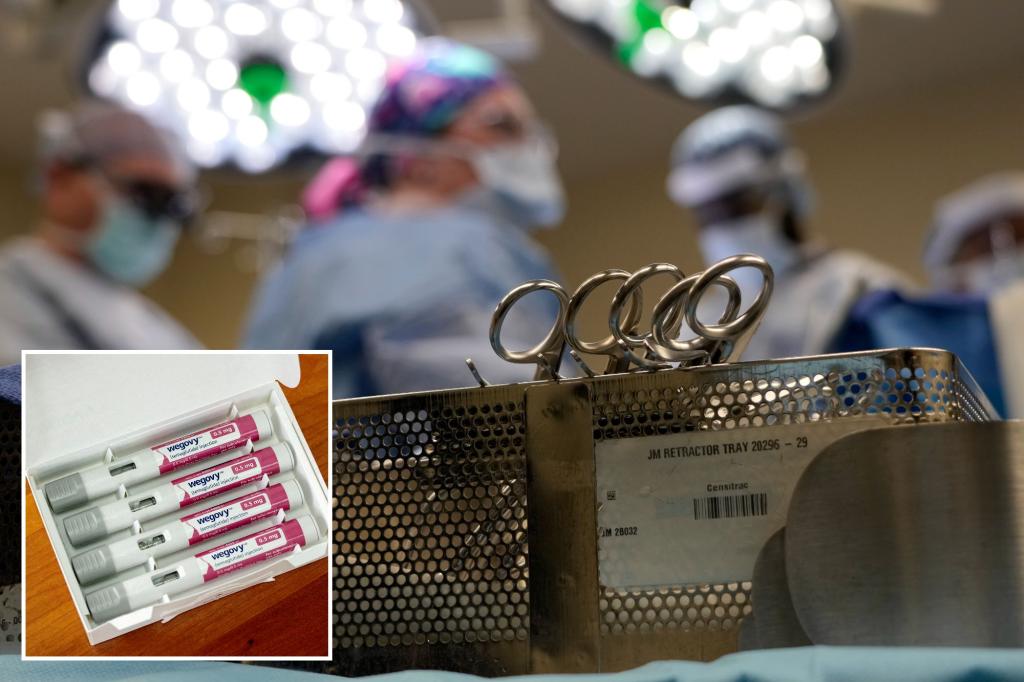뉴스&스피킹(영자신문)
하루 10분이면 영어에 대한 두려움을 극복하고 누구나 유창하게 영어를 구사하실 수 있습니다.
-
 Weight Loss Drugs May Risk Complications under Anesthesia Doctors who practice anesthesiology in the United States and Canada are expressing concern about patients who take popular weight loss drugs leading up to surgery.
Weight Loss Drugs May Risk Complications under Anesthesia Doctors who practice anesthesiology in the United States and Canada are expressing concern about patients who take popular weight loss drugs leading up to surgery.
Anesthesiologists work together with surgeons to make sure their patients are asleep, or sedated, before medical procedures.
More and more people are taking the weight loss drugs Ozempic and Wegovy. Anesthesiologists say they are having trouble deciding when surgeries should take place.
That is because the weight loss drugs cause people to hold food in their stomachs longer than usual.
People who still have food in their stomachs when they are put to sleep before surgery risk a complication known as a pulmonary aspiration. That is that is the term for when someone breathes some of their stomach contents into their lungs. In extreme cases, the food particles can cause infection or even death.
Most patients are told to not eat for about eight hours before surgery. However, the doctors say those guidelines may need to be changed for patients who are using the weight loss drugs.
Ion Hobai is an anesthesiologist at Massachusetts General Hospital in Boston. He said everyone who takes the drugs should know about “such a serious sort of potential complication.”
Komodo Health is a technology company that works in healthcare. According to its research, nearly 6 million prescriptions for the weight loss drugs were written in the first five months of 2023.
In June, the American Society of Anesthesiologists said patients should not take daily weight loss medications on the day of surgery. It also advised that patients should not get their weekly weight loss injection for a week before any sedation procedures.
Dr. Michael Champeau is the head of the organization. He said the recommendation is based on experiences from anesthesiologists around the United States.
A group of anesthesiologists, including Hobai, said they would recommend even more time off from the drugs before surgery. In the Canadian Journal of Anesthesia, they suggested about three weeks.
Dr. Philip Jones is an anesthesiologist at the Mayo Clinic in Minnesota. After three weeks, he said, the drug should no longer be affecting the stomach. At that point, he said, “everything should go back to normal.”
Hobai said he is finishing a study of 200 patients who were using drugs such as Ozempic and Wegovy before surgery. He said his results are similar to a smaller study in Brazil that found 25 percent of patients still had food in their stomachs 10 days after stopping the drug.
Because of this information, the American Society of Anesthesiologists said doctors who are unsure of their patients’ stomach contents should work differently. They say doctors should work as they would if they knew the patient’s stomach was full.
Aspiration only happens one time out of every 2,000 to 3,000 operations that require sedation. But when it does happen, the patients develop a lung injury half the time. That is why the doctors are concerned.
One of Hobai’s patients who had been taking Wegovy developed a problem that required serious care. He had not eaten for 18 hours before surgery.
In another case, a woman taking a small amount of Ozempic did not eat for 10 hours before surgery. She was in the middle of a procedure that had to be stopped because doctors saw food in her stomach.
Dr. Elisa Lund is an anesthesiologist at the University of North Carolina in Chapel Hill. She said many doctors have similar stories, as the weight loss drugs have become more common.
“It has exponentially increased,” she said.
Novo Nordisk is the drug company that makes Wegovy and Ozempic. The company said there was nothing in its testing that showed the drug would lead to aspiration. However, the drug-maker did say the medications can cause the stomach to empty more slowly.
Hobai said he is also concerned about patients going off their medications for too long. For example, the drugs are used to control the blood sugar level of patients with diabetes. If they stop taking them before surgery, they may face a different kind of health problem.
He said patients who are using the drugs should tell their doctors about them and discuss the risks of having surgery.
“If you’re taking this drug and you need an operation, you will need to have some extra precautions,” he said.
I’m Caty Weaver. And I’m Dan Friedell.View -
 Fiction Writers Fear the Rise of AI, and See it As a Story to Tell For many book writers, artificial intelligence (AI) is a threat to their jobs and the very idea of creativity. More than 10,000 writers and others supported an open letter about the issue from the Authors Guild this summer. The letter urged AI companies not to use copyrighted work without permission or payment.
Fiction Writers Fear the Rise of AI, and See it As a Story to Tell For many book writers, artificial intelligence (AI) is a threat to their jobs and the very idea of creativity. More than 10,000 writers and others supported an open letter about the issue from the Authors Guild this summer. The letter urged AI companies not to use copyrighted work without permission or payment.
At the same time, AI is a story to tell, and no longer just in science fiction.
Helen Phillips is the writer of the upcoming book HUM. It tells of a wife and mother who loses her job to AI.
“I’m frightened by artificial intelligence,” but also interested in it, she explained.
Phillips said there is a hope in AI for gaining all knowledge, the understanding of everything. But at the same time, there is an “inherent terror in being replaced by non-human intelligence.”
Ryan Doherty is a vice president and director at Celadon Books. It recently agreed to publish Fred Lunzker’s book Sike, featuring an AI psychiatrist, a doctor of mental health.
“We’ve been seeing more and more about AI in book proposals,” Doherty said.
Doherty used the term zeitgeist, meaning the general ideas or spirit of a time, to describe AI.
“It’s the zeitgeist right now. And whatever is in the cultural zeitgeist” gets into fiction, Doherty said.
Other AI-related books expected in the next two years include Sean Michaels’ Do You Remember Being Born?. That story tells of a poet who agrees to work with an AI poetry company. Also upcoming is In Our Likeness, by Bryan Van Dyke. It tells about a government worker and a fact-checking program with the power to change facts.
Another novel, A.E. Osworth’s Awakened, tells about a witch and her clash with AI.
And, crime fiction writer Jeffrey Siger, known for his books set in modern Greece, is working on a book touching upon AI and the metaverse.
Writers are also using AI to address the most human questions.
In Sierra Greer’s Annie Bot, the title character is an AI mate designed for a human male. For Greer, the book was a way to explore the character’s “urgent desire to please.” She said the robot mate permitted the writer “to explore desire, respect, and longing in ways that felt very new and strange to me.”
Amy Shearn’s book, Animal Instinct, has its beginnings in the pandemic and in her personal life. She had recently divorced and began to use dating apps.
“It’s so weird how, with apps, you start to feel as if you’re going person-shopping,” she said. “And I thought, wouldn’t it be great if you could really pick and choose the best parts of all these people” you see and mix them together to make your ideal person?
“Of course,” she added, “I don’t think anyone actually knows what their ideal person is, because so much of what draws us to mates is the unexpected, the ways in which people surprise us.”
Some writers are not just writing about AI. They are also openly working with it.
Earlier this year, Stephen Marche used AI to write the short book Death of An Author. Simon Rich worked with Brent Katz and Josh Morgenthau for I Am Code, a thriller in verse that came out this month. The AI program “code-davinci-002” created the work.
I’m John Russell.View -
 Young Chinese Turn to Online Streaming to Earn Money Many young Chinese are increasingly turning to online streaming as a way to earn money while selling products for major companies.
Young Chinese Turn to Online Streaming to Earn Money Many young Chinese are increasingly turning to online streaming as a way to earn money while selling products for major companies.
The job involves livestreaming on popular social media services in China. A person leading such livestreams is known as a host. The goal is to persuade users to spend money with large brands such as Under Armor, Lancôme, YSL Beauty and Hugo Boss.
One such streamer is 28-year-old Zhang Jinyu, a former model who studied fashion in college. She told reporters from Reuters news agency she has already completed hundreds of hours of live streams to publicize products for YSL Beauty and other brands.
Zhang’s livestreams can involve her continuously speaking on camera for up to six hours. In addition, the preparation process requires her to do her hair and makeup and spend time recording sales results after her online broadcasts have ended.
Reuters reports that Zhang is one of millions of young Chinese currently facing record youth unemployment of more than 21 percent. Livestreaming sales is one way social media users can earn money without having to get a full-time job.
"For livestreaming, the threshold to enter the industry is very low,” Zhang said. “I can pick up my phone and I'm livestreaming.” She noted, however, that livestream selling is now very competitive, making it difficult for newcomers to gain a following. "If you can persevere, you can get better and better,” Zhang said.
Zhang is not alone in her desire to make livestream hosting a career. A recent public opinion study asked more than 10,000 young people on China’s social media service Sina Weibo how they feel about the issue. More than 60 percent said they would be interested in working as an internet influencer or livestreaming host.
A study by China-based marketing agency iResearch found the livestreaming industry employed more than 1.2 million hosts as of 2020. The COVID-19 pandemic helped lead livestreaming sales growth that brought in about $480 billion in China last year.
That growth led to a series of agencies being created that aim to train new hosts and connect them with established brands.
Zhang, for example, works with Shanghai-based agency Romomo. The company is a business partner of Buy Quickly, which helps hosts link up with major fashion-centered brands.
Shining Li is vice president of Romomo. She told Reuters she thinks livestreaming is currently “one of the most important methods of communication” for the international brands she works with.
Shi Jianing is a 28-year-old livestreaming host. She says her broadcasts are a good way for her to build lasting relationships with followers and increase sales for the brands she represents.
"We're like friends with the consumers," Shi said. She added, “If you can communicate with some personal affinity, that builds a kind of trust, and that relationship makes the consumer want to carry out the sale."
I’m Bryan Lynn.View -
 Japan to Release Wastewater from Fukushima Nuclear Plant Japan’s Prime Minister, Fumio Kishida, signed off Tuesday on his country’s plan to release treated and diluted radioactive wastewater from the Fukushima nuclear plant later this week.
Japan to Release Wastewater from Fukushima Nuclear Plant Japan’s Prime Minister, Fumio Kishida, signed off Tuesday on his country’s plan to release treated and diluted radioactive wastewater from the Fukushima nuclear plant later this week.
If weather and sea conditions are good, Tokyo Electric Power Company Holdings, or TEPCO, will start to release the water into the Pacific Ocean on Thursday.
The water release is an important part of the process of cleaning up the plant, which was damaged by a disastrous earthquake and tsunami on March 11, 2011. A tsunami is a large ocean wave created by the movement of the land under the ocean.
The wave destroyed the power center’s cooling systems and caused three of the plant’s nuclear reactors to overheat, or meltdown. The result was contaminated cooling water that has been treated and stored for over 10 years.
The prime minister said everything has been done to ensure the plan’s safety and to protect Japan’s fishing industry. He said the government will continue to explain the plan’s science until the cleanup is completed many decades from now. A decade is a period of 10 years.
Kishida said, “The government will take responsibility until the disposal of the…treated water is completed.”
The government of South Korea said it understands the plan and it will hold Japan to its promises to supervise the safety of the water. South Korea agreed to support Japan’s plan even with protests by lawmakers and activists.
Other East Asian nations, however, are not pleased with the plan to release the water. Hong Kong and Macau both said they would ban products from Fukushima and nine other parts of Japan. China said it will increase radiation testing on fish imported from Japan.
Japanese fishing organizations protested the plan partly because they are worried about being able to sell their catch.
But TEPCO says about 1,000 storage tanks which have held the contaminated water since the disaster of 2011 are now almost full. The company is also concerned about possible leaks. So, the treated water must be released.
Junichi Matsumoto is the TEPCO leader in charge of the water release. In an interview with the Associated Press last month, he said the release is “a milestone” but there is still a lot of work to do to close down the plant.
TEPCO will start by releasing 7,800 tons of water over the first 17 days. All of it will be diluted with seawater to reach safe levels of radiation. By March 2024, TEPCO plans to release over 31,000 tons of water. However, that equals only 10 of the 1,000 storage tanks. The speed of the release will increase over time.
The International Atomic Energy Agency (IAEA) said in July that Japan’s release plan will have almost no effect on human health or the environment.
Rafael Grossi is the director general of the IAEA. He said the United Nations office at the plant will remain open to monitor the water as it is released.
Most scientists agree with the IAEA, but they said the slow release of radioactive water, even at very low levels, needs attention.
Japan’s government is continuing to explain the plan in nearby countries so that the release does not damage diplomatic communication. TEPCO is also considering accepting responsibility for the financial losses of the Japanese seafood industry because of restrictions placed on its products by other countries and extra testing requirements by China.
I’m Dan Friedell.View -
 India Prepares Moon Landing after Failed Russian Attempt India will soon attempt to land a spacecraft on the point farthest south on the moon, its south pole.
India Prepares Moon Landing after Failed Russian Attempt India will soon attempt to land a spacecraft on the point farthest south on the moon, its south pole.
The attempt comes just days after the failure of a Russian moon lander. India's space agency on Monday released images its spacecraft captured on the far side of the moon. That is the part of the moon that cannot be seen from Earth.
The Indian Space Research Organization (ISRO) launched the spacecraft called the Chandrayaan-3. ISRO had been in a race with Russia to be the first national space agency to land on the lunar south pole. The area is thought to hold water ice that could support a future moon settlement.
As news of the failure of Russia's Luna-25 mission spread on Sunday, ISRO said that Chandrayaan-3 was set to land on August 23.
The mission is India's second attempt to land on the south pole of the moon. In 2019, ISRO's Chandrayaan-2 mission successfully launched an orbiter, but its lander crashed. Chandrayaan means "moon vehicle" in Hindi and Sanskrit
The ground at the lunar south pole is uneven making landing there difficult. A first landing would be historic. The area’s water ice could supply fuel, oxygen and drinking water for future missions.
Images released on Monday showed craters on the moon’s surface captured by the spacecraft’s camera. The camera is designed to help identify a safe landing place for the spacecraft.
India's moon mission launched on July 14. The Chandrayaan-3’s lander separated from the rest of the spacecraft last week.
For India, a successful moon landing would mark its arrival as a world space power. Prime Minister Narendra Modi's government aims to increase investment in private space launches and related satellite-based businesses.
Manish Purohit is a former ISRO scientist. "If Chandrayaan-3 succeeds, it will boost India's space agency's reputation worldwide,” he said.
Russia’s Luna-25 crashes
Russia’s Luna-25 spacecraft crashed into the moon after it went into an uncontrolled orbit, the country’s Roscosmos space agency said Sunday. The pilotless spacecraft had been expected to land Monday.
However, Roscosmos said it lost contact with the Luna-25 on Saturday after the spacecraft reported problems.
Vitaly Egorov is a popular Russian space expert. He said the mission had some successes although it crashed.
“Luna 25 showed important progress. It flew toward the Moon, carried out orbit correction, and tested onboard electronics and scientific tools,” he said. “Russian cosmonautics was not at this level before. But then, an error occurred somehow.”
The lunar mission was Russia’s first since 1976, when it was known as the Soviet Union. Only three governments have successfully landed on the moon: the Soviet Union, the United States and China.
Scientists at ISRO have said they learned from the earlier moon mission’s failure and made changes to Chandrayaan-3. They said a successful landing is now more likely. The changes include making it possible to land safely anywhere within a larger landing area in difficult conditions. It also holds more fuel, carries additional solar panels and has stronger legs.
I’m Dan Novak.View

